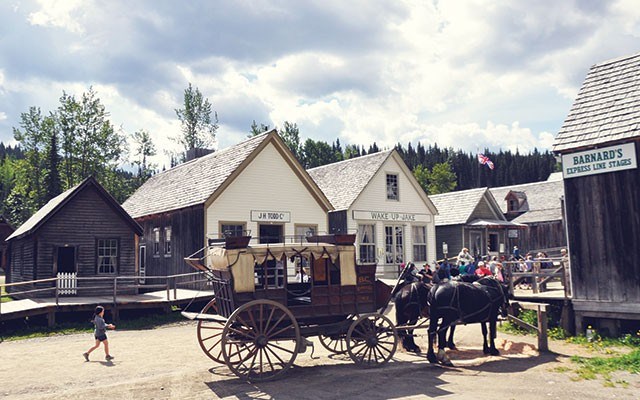Ever pick up hitchhikers? That decision usually depends on appearances and circumstances. A thumber's chances of a ride are far better on country roads, where the sense of distance between towns plays on drivers' heartstrings.
One such stretch lies along the highway that traces the Gold Rush Trail between Quesnel on the Fraser River and Barkerville, the mining mecca of the Cariboo Mountains. Barkerville was the centre of the 1860s gold stampede credited with forging British Columbia's political identity, first as an embryonic British colony, then, eventually, a province.
No need to rush along this scenic route during a summer road trip. Justifiably known at the time as the 8th Wonder of the World, the wagon road that once linked the Fraser Valley with the Cariboo gold fields is where Pique came upon James Douglas while on a drive through the B.C. Interior.
The nattily attired gent toted a classic Trapper Nelson external-frame backpack, complete with a gold pan. Who wouldn't slow down to give such a dude the once-over? An offer of a lift won quick acceptance.
As often happens when one encounters solo adventurers, Douglas was far more than first met the eye. It turned out that not only was he manager of visitor experiences and public relations at Barkerville Historic Town, the 43-year-old was also a font of wisdom on gold — and he sported a leather bag of the yellow nuggets to boot.
"Current scientific theories on the origins of gold are that the element arrived as dust from supernovae when the Earth was in its formative stage," he explained as he settled in for the ride. "Around here, it occurs just below the bedrock in narrow valleys ground out by glacial ice."
With that, he unrolled his poke. Shiny, gnarled nuggets tumbled onto his palm. "You can tell this is from the Barkerville region by the slight green tinge, owing to the presence of copper in local creeks. It's about 85- to 90-per-cent pure."
Asked about value, Douglas replied that nuggets today are worth far more as jewelry than as regular gold, given that most such specimens were mined long ago and are now rare. He added: "Four tons of gold were taken from a two-mile (three-kilometre) stretch of Williams Creek where Barkerville sits, the richest gold source in the world."
Although reaching Barkerville from Whistler is much easier now than in the 1800s, you should budget at least two days to enjoy the 600-kilometre drive. There's plenty of Gold Rush Trail memorabilia on display in places such as Lillooet, Clinton, and Quesnel. The slower you approach, the greater the sense of accomplishment on arrival. This was the pinnacle sought by 30,000 stampeders who set out from Victoria, where most initially landed by ship from San Francisco. The hardships faced along the way were reflected in the fact that only 7,000 made it to El Dorado.
At Barkerville's entrance, the packed-dirt surface of Front Street spills out of the surrounding forest and leads for several blocks past well-kept two- and three-storey wood-frame establishments before being swallowed up in dense greenery once more. On a visit there in 1906, Vancouver poet Pauline Johnson observed that, on account of most buildings being built on stilts to avoid floodwaters during Williams Creek's spring freshets, "the whole town has the appearance of someone raising their eyebrows."
In 1958, the provincial government started acquiring townsite lots in order to operate it as a historic site. Today, only three private properties remain: St. Saviour's Anglican Church, the Masonic Hall, and a family home. All told, 18 businesses do a thriving trade. Tourists from around the globe, including an increasing number from China, mix with school groups. (The history of both the Fraser Canyon and subsequent Cariboo gold rushes is studied as part of the B.C. public-school curriculum in Grades 5 and 10.)
A contingent of Chinese panners sought their fortunes here as well. Walk beneath an archway that defines the Chinatown precinct to gain a sense of how two worlds merged here. Archaeologist and Barkerville historian Ying-ying Chen told Pique that what set the two camps apart was their reaction to the sudden wealth that came with a gold strike. "Whereas European miners were quite flamboyant, the Chinese mentality was to be conservative. A lot of gold was sent back to China, where it helped fund the Revolutionary Alliance that eventually overthrew the last dynasty and established a republic. That's an unknown chapter of Chinese history in B.C. that occurred well before the construction of the railway and one that Chinese tourists today find compelling."
Care to unearth more nuggets of your own? Stop by A. McPherson Watchmaker and Jeweller and pick up a poke, then head to the House Hotel Coffee Saloon for a jar of Barkerville Brewing's liquid gold. That's a refreshing way to start, and it's guaranteed to slake any incipient gold-rush fever.
Access
Barkerville lies 600 kilometres north of Whistler via highways 99, 97, and 26. For information on the Gold Rush Trail tourism route, visit www.goldrushtrail.ca. Details on Barkerville are posted at www.barkerville.ca.
Jack Christie is the author of The Whistler Book (Greystone). For details, visit www.jackchristie.com.




